|
The
|
THE BURGENLAND BUNCH NEWS - No. 253 March 31, 2015, © 2015 by The Burgenland Bunch All rights reserved. Permission to copy excerpts granted if credit is provided. Editor: Thomas Steichen (email: tj.steichen@comcast.net) Archives at: BB Newsletter Index Our 19th Year. The Burgenland Bunch Newsletter is issued monthly online. It was founded by Gerald Berghold (who retired Summer 2008 and died in August 2008). |
Current Status Of The BB: * Members: 2321 * Surname Entries: 7570 * Query Board Entries: 5442 * Staff Members: 17 |
This newsletter concerns: 1) THE PRESIDENT'S CORNER 2) THE FRENCH CONNECTION 3) PROPER PEASANTS: FAMILY STRUCTURES 4) PHOTO IDENTIFICATIONS NEEDED - RESPONSE 5) TORONTO'S HUNGARIANS AND BURGENLÄNDERS 6) HISTORICAL BB NEWSLETTER ARTICLES: - QUESTIONS CONCERNING ZAHLING-ELTENDORF-KUKMIRN CHURCH RECORDS (SOUTHERN BURGENLAND) 7) ETHNIC EVENTS 8) BURGENLAND EMIGRANT OBITUARIES (courtesy of Bob Strauch) |
1) THE PRESIDENT'S CORNER (by Tom Steichen)  Concerning
this newsletter, after the bits and pieces here in my "Corner," which includes a fair number of
responses from readers to last month's newsletter, Article 2, The French Connection,
provides a possible explanation as to why you might harbor a touch of French DNA in your
otherwise Burgenland makeup... and maybe even a French-based surname. Concerning
this newsletter, after the bits and pieces here in my "Corner," which includes a fair number of
responses from readers to last month's newsletter, Article 2, The French Connection,
provides a possible explanation as to why you might harbor a touch of French DNA in your
otherwise Burgenland makeup... and maybe even a French-based surname.Article 3 is a long-awaited second article (at least by me, as I thought I'd write it sooner) based on the book Proper Peasants. This one addresses the traditional Family Structures found in the Hungarian plains. Article 4 is a Follow-up to last month's Photos that Need Identifications. While that follow-up could not identify the people involved, it does help narrow the time period greatly as well as explain the general nature of the group shown. Like always, I used that as a basis to expound upon some related general-interest information. Article 5 deals with Toronto, Canada, and the Hungarian and Burgenländer communities therein. Unfortunately, it also speaks of the loss of its ethnic-Hungarian businesses and neighborhoods. The remaining articles are our standard sections: Historical Newsletter Articles, and the Ethnic Events and Emigrant Obituaries sections.  Next
Month's Newsletter... will be a reduced, minimal version, as I will be away for
substantial portions of the month and will not have much time to assemble a newsletter. In
addition, I have only a little material waiting in my publication queue and I currently have few
ideas for topics worth writing about (it does happen!). So, if you have ideas for worthwhile
articles or are willing to write one yourself, please send them in. As always, I expect that a
short sabbatical from writing/publication duties will refresh my enthusiasm... but any
contributions you folks can make will be greatly appreciated! Next
Month's Newsletter... will be a reduced, minimal version, as I will be away for
substantial portions of the month and will not have much time to assemble a newsletter. In
addition, I have only a little material waiting in my publication queue and I currently have few
ideas for topics worth writing about (it does happen!). So, if you have ideas for worthwhile
articles or are willing to write one yourself, please send them in. As always, I expect that a
short sabbatical from writing/publication duties will refresh my enthusiasm... but any
contributions you folks can make will be greatly appreciated! Last
Month's Newsletter: The articles and commentary in last month's newsletter precipitated
a number of responses from BB members... Last
Month's Newsletter: The articles and commentary in last month's newsletter precipitated
a number of responses from BB members...Hannes Graf wrote, after the death of Ladislaus Pascal Prince Batthyány-Strattmann of Német-Ujvár (Güssing), to note that "...the 'new' prince, Ladislaus Edmund Batthyány, is a longtime BB-member!" This is true and Ladislaus himself notes in his Member entry that, not surprisingly, he is "specially interested in Burg (Castle) Güssing and its future." Willi Schmidt wrote to correct some of my spellings (now corrected, one of the benefits of an online newsletter) and to comment on the Historical Article sequence about Croatians in Burgenland. He said: "The presence of Kroats in various villages has to be carefully examined. For example: In 1542, Kroats were settled in what is – since 1715 – called Kroatschützen. My great-grandfather, Lucas Bugnits came from there to Pernau, about 1880. I jumped to the conclusion that his ancestry goes back to the immigrants of 1542. But the census of the village made in 1720 lists no Bugnits. Also, my great aunt Margaret Meltsch married Ignaz Bugnitz. He definitely came to Pernau from Harmisch. Apparently it was the original place where the Bugnitzes settled – and live to this day. The forebears of Lucas must have come from there – the different spelling of the surname notwithstanding. The lack of birth records prior to about 1800 keeps me from establishing their consanguinity." Randy Gradwohl, with tongue buried deep in cheek, wrote to claim "I found your story about the phishing scheme interesting but must call you out on one point. One line read, 'The hacker captured our page, found text strings in it that could be email addresses and inserted @ characters in likely spots. He then used these constructed email addresses in a spam message.' The use of the word 'he' in this article offends me. You jumped to the conclusion that the perpetrator was a male. I was born male and have to say I am damn proud of my heritage and to see someone automatically pin such activities to persons of my gender is insulting. Such sexist attitudes and negative representations of the male gender must stop!" We had a fun exchange based on that wherein I agreed I had insulted us men (especially myself) and, as a result, chose to change the pronoun to "she," as I hate the "(s)he" construct and thought you ladies out there deserved a little bad-girl vibe! Randy suggested I use the universal pronoun, one formed from the contraction and combination of she, he and it. I won't give it here (only four letters, so I'm sure you can work it out) and I didn't use it but I will note that it is particularly appropriate for hackers and spammers! Nina Egert wrote (in part) that "your comment about a new Austro-Hungarian cafe reminded me of something that I thought I might mention to you. A few years ago, right when I was starting to do research on the history of my local neighborhood, someone published a book that mentioned a group of Germanic people who had a retreat center adjacent to Holy Names College (down the street from where I lived and, coincidentally, right above the Mormon Temple with the genealogy center). I went to check it out -- every Sunday they have this great polka dance party out on the deck of their retreat center (after an outdoor Catholic Mass) where people can dance and stuff themselves silly on beer and sausages. My folks had just passed the year before, so this was bitter-sweet, as they would have loved this. I would have killed to know about these people while my folks were still alive and visiting me, so I could have taken them there. Here's the link to their website (history page): http://thenaturefriendscorporation.org/history.html." Steve Dikovics wrote that "when I read your adventures with paprika it made me think of Paprikas Weiss, a wonderful store in Manhattan that's now sadly gone. I've attached an article below that I think you'll enjoy. I bought paprika from them when I worked in NYC." (See On the Upper East Side, Memories Fueled by Strudel for commentary on now mostly-gone NYC ethnic neighborhoods and businesses). Richard Potetz wrote: "One of my memories resurrected by your discussion of paprika is of a paprika-covered block my dad would buy occasionally called 'speck.' This was not bacon as we know it, not sliced, just a block, similar to bacon but with just the fat, no stripes of meat at all, about the size of a can of spam. He ate it with rye bread, for him a treat that reminded him of his homeland."  Burgenland
Church Names: A recurring question is of the form, "What is the name of the church in
[some village]?" It is one I usually can answer fairly quickly for Catholic churches, as I
know a web source for those answers, but, even then, I occasionally struggle to recall the
correct website! As for Lutheran churches and Jewish synagogues, those are much harder to find!
Also, I suspect Lutheran churches and Jewish synagogues were less likely to be named (beyond
being for the village they were in). Burgenland
Church Names: A recurring question is of the form, "What is the name of the church in
[some village]?" It is one I usually can answer fairly quickly for Catholic churches, as I
know a web source for those answers, but, even then, I occasionally struggle to recall the
correct website! As for Lutheran churches and Jewish synagogues, those are much harder to find!
Also, I suspect Lutheran churches and Jewish synagogues were less likely to be named (beyond
being for the village they were in).Thus, I've started a project to add church names to our Villages pages. So far, I have added most of the Catholic and Lutheran ones, and I hope to add those for the remaining churches in the near future. Documentation of synagogues is more difficult, given that all Burgenland Jewish communities, along with most of their synagogues, were destroyed but the Nazi pogroms of 1938. However, I think I've found most of them (or at least the villages they were in). Synagogue entries include a notation indicated the time span the synagogue existed. If you know the formal or dedication name for a Burgenland church/synagogue that has yet to be added (or one I need to correct), please send me a note with the village name, religious affiliation, and church/synagogue name. Better yet, if you know an online source for such names, send that to me! Please! Please note also that I am entering only parish churches plus Catholic filial (branch) churches or Lutheran tochter (daughter) bethausen (prayer houses) where formal services are regularly held (usually once a month)... no chapels. There are literally thousands of chapels in Burgenland, and no matrikels records are kept at them, so these I'm ignoring. You can click the Villages link (above) to see what I already have documented. Generally, parish churches/synagogues are referred to by the name of the village they are in and their religious affiliation, but it is still nice to know the associated dedication name (if any). That is the purpose of this effort. Primary sources used in this project: Lutheran: http://evangnet.at/cms/front_content.php?idcat=38 Catholic: http://www.martinus.at/adressbuch/gruppe/2131120131654051.html Jewish: http://www.austriansynagogues.com/index.php/archive?sid=55:burgenland  DNA
Project Scope Expanded: Frank Paukowits, the Group Administrator of the
Burgenland DNA Study Project, indicated that the scope of the Project has been
expanded to include women in the testing process. Formerly, the Project was restricted to
males via testing of Y-DNA, the gene passed from father to son and
giving the strictly-paternal ancestral line origins. Frank said it makes sense to expand testing
to get a more comprehensive picture of the make-up of the people from Burgenland. DNA
Project Scope Expanded: Frank Paukowits, the Group Administrator of the
Burgenland DNA Study Project, indicated that the scope of the Project has been
expanded to include women in the testing process. Formerly, the Project was restricted to
males via testing of Y-DNA, the gene passed from father to son and
giving the strictly-paternal ancestral line origins. Frank said it makes sense to expand testing
to get a more comprehensive picture of the make-up of the people from Burgenland.Under the change, testing can now be done on mitochondrial DNA (mtDNA), which is genetic material that is associated with the female side of the family and giving the strictly-maternal ancestral line origins. While both men and women can have an mtDNA test performed, only women can pass mtDNA to children. The results will be incorporated into the periodic reports that are issued on the Project. Currently, the Project has 141 participants and a number of females have been tested. However, because of the limited size of the female sample, no hard conclusions can be drawn yet. MtDNA testing can be secured for as little as $49. A more comprehensive test providing more reliable results would cost $199, but a rebate of $40 brings the net cost down to $159. Also as part of this major revamping of the Burgenland Study Project scope, people (men or women) who have had autosomal (atDNA) testing done can now be included in the Project. Unlike Y-DNA and mtDNA, atDNA will give you a composite of your origins rather than just the strict maternal or paternal lines. Family Tree DNA (FTDNA), the company sponsoring the Project, has a program which provides for the free transfer of autosomal test results from other companies. If you haven’t been tested yet, FTDNA will charge $99 for their autosomal test, which is called, “Family Finder.” If anyone has questions on the protocol to be used for joining the Project and /or the procedures to be used for securing any one of the prescribed tests, you can direct your inquiries to Frank Paukowits at paukowits1@aol.com. [Ed. Note: I recently received my autosomal DNA results and added that data to this project. Because my paternal line goes back to Luxembourg, I had not joined the Burgenland project when it was only Y-DNA... it would have made no sense! However, my maternal line does come from Burgenland—and the Burgenland DNA project now includes mtDNA too—so I may choose to have that type of analysis done soon; perhaps it will show a detectable relationship to other participants (my autosomal results did not!).]  Burgenland
Discount Card: For those among you who might be traveling in Burgenland this year,
Burgenland Tourism is making available, starting April 1, a regional tourist discount card, good
for free or reduced admission at 87 destination attractions within Burgenland. The card costs
€ 59 for an adult (€ 29 for children 5-14
years old) but is said to offer discounts totaling over € 400 if fully
utilized. Burgenland
Discount Card: For those among you who might be traveling in Burgenland this year,
Burgenland Tourism is making available, starting April 1, a regional tourist discount card, good
for free or reduced admission at 87 destination attractions within Burgenland. The card costs
€ 59 for an adult (€ 29 for children 5-14
years old) but is said to offer discounts totaling over € 400 if fully
utilized.[Note: The Burgenland Card should not be confused with the Neusiedler Card, which is free for all registered visitors in Burgenland (see: http://www.neusiedler-see.at/neusiedler-see-card.42.0.html for details about the Neisiedler Card... it is a much better option if you intend to stay, or play, in just Northern Burgenland!).] With the Burgenland Card, Burgenland is following in the tracks of Carinthia and Lower Austria, which offered similar regional tourist cards in past years. The cards provide discounted or free admission to museums, amusement parks, spas, swimming pools, attractions and events. The cards are particularly attractive to water lovers who would like to explore what Burgenland offers: they give 50% discounts at five Thermal Baths and one-time free access to some 30 resorts and indoor and outdoor swimming pools, In addition, the Lake Neusiedl ferry from Breitenbrunn to Podersdorf is free once. A one-time entrance to various cultural institutions, especially museums, and various events also are free or discounted 10-25%. Likewise, certain leisure facilities, especially for children, are covered. There is a 50% discount to the Family Park and free entry to the Reptile Zoo Forchtenstein. If interested, you should, of course, read the small print and think carefully about whether buying the Burgenland Card will enhance your visit or merely tempt you to try to force too many additional things into what probably is already a full visit schedule in Burgenland. For more information, see: http://www.burgenland.info/de/burgenland-entdecken/burgenland-card.html. Bittersweet Memories - The Sugar Industry in Burgenland: Last month (on March 8), burgenland.orf.at television presented a Landesstudio Burgenland (National Studio Burgenland) production titled "Bittersweet Memories - The Sugar Industry in Burgenland" about a former sugar factory in Siegendorf (in the Eisenstadt district of northern Burgenland, near the border with Hungary above Sopron). 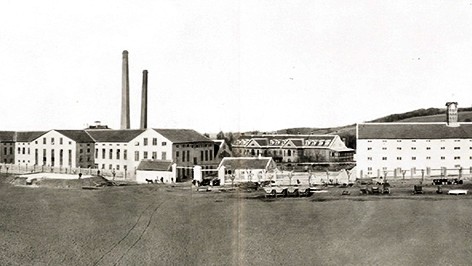 Although
the sugar factory, which was founded in 1852, closed its doors in 1988, its site and some of its
buildings remain in use, housing the Gewerbezone Ost (Commercial Zone East), a home to
many companies from different industries that employ a total of 800 workers. Although
the sugar factory, which was founded in 1852, closed its doors in 1988, its site and some of its
buildings remain in use, housing the Gewerbezone Ost (Commercial Zone East), a home to
many companies from different industries that employ a total of 800 workers.The initial owner of the now-defunct sugar factory was Conrad Patzenhofer, whose family became employers and patriarchs in the local Burgenländer-Croatian community. Conrad was born in Bavaria in 1821 and supervised the construction of a sugar factory in nearby Hirm (in the Mattersdorf district). 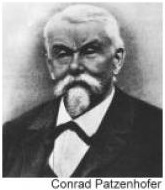 When
another entrepreneur channeled and drained the "Sulzbreiten," a shallow, swampy lake east of
Siegendorf, to plant sugar beets, Patzenhofer saw the opportunity to open a sugar-processing
plant of his own. When
another entrepreneur channeled and drained the "Sulzbreiten," a shallow, swampy lake east of
Siegendorf, to plant sugar beets, Patzenhofer saw the opportunity to open a sugar-processing
plant of his own.The TV show, with the help of historical photographs and films about the heyday of the sugar industry in Burgenland, explores the buildings and interviews ex-workers, historians and descendants of the former owners. In its 136 years of existence in Siegendorf, thousands of people found employment and earned their livelihood in the sugar factory. If your family comes from the area, it seems likely that some of your ancestors may have worked there or in the local sugar beet fields. Even if more distant, your ancestors may have worked the many other sugar beet fields of West Hungary that also supplied the factory with raw material. Below is (an unrelated) short (2:43) annotated YouTube slide show about the factory (there is a musical sound track but no voiceover). After starting the show, you can click the rectangle in the lower right corner of the video insert to view it full screen: Email Hacking Revisited: Last month I wrote about the probable capture of some pseudo-email addresses from the BB pages (and our fix for the problem). This month, I was on the other end of the problem... someone else apologizing that his email was hacked and fictitious (phishing) emails were sent out as if they were from him: Christian G Geosits writes: Dear irritated person, it appears some naughty person (pauleve@fyi-net) somehow hijacked my e-mail address and promises you to make money from home. Don't believe it, keep your current jobs and delete the message. In case you wonder who I am - I, too, agree that I should clean up my address book and now wonder where some of the entries come from. In case you do not wonder - all is well and Priština [, Kosovo] is snowy and nice today. Please accept my apologies. Christian's email apology was so well done that I thought it was well worth sharing with you. I only hope that all who received the phishing email reacted equally kindly. For the record, I will note that I did not (yet) receive the phishing attack that Christian writes about, nor do I have Christian's email address in my email address book. Further, Christian is not a BB member (though I strongly suspect that it was through the BB or one of our members that Christian somehow acquired my email address). I find no messages between us over the last few years, even though I tend to store those related to the BB. I thank Christian for making my day a little nicer!  WWW.GenTeam.Eu
March Updates: GenTeam.eu recently announced the addition of ~230,000 records to their
site, bring their total online record count to ~11.6 million. The additions are as follows: WWW.GenTeam.Eu
March Updates: GenTeam.eu recently announced the addition of ~230,000 records to their
site, bring their total online record count to ~11.6 million. The additions are as follows:1. New birth index of Vienna Civil Registries for the time frame of 1867-1896 for people not confessing any faith (i.e., atheists, deists, and individuals who are not affiliated with any religion or are members of unrecognized religions). 2. Name Index for the book "Der Adel der Habsburgermonarchie" (Nobility of the Habsburg Monarchy) by Dr. Georg Frölichsthal. 3. Index of Catholic Baptisms in Vienna, 1585-1900. ~115,000 records added to the ~827,000 records already online: Parishes added: 01 Saint Stephan, 01 Bürgerspital (Citizens Hospital), 02 Saint Josef, 02 Saint Leopold, 03 Rennweg, 04 Saint Elizabeth, 04 Saint Karl Borromäus, 04 Wieden (Paulaner), 05 Saint Florian (Matzleinsdorf), 05 Saint Josef Margareten, 06 Gumpendorf, 07 Schottenfeld, 08 Mariatreu (Piarists), 08 Gebäranstalt (Birthing Institute), 09 Votiv Kirche (Votive Church), 09 Lichtental, and 18 Währing (the number is the district within Vienna). 4. Index of Catholic Deaths in Vienna: added to the compilations of the hospitals of the 3rd District of Vienna were the following: the whole 1st District of Vienna for the years 1900-1938 (am Hof to 1907, Deutscher Orden, Hofburg to 1919, Maria Rotunda, Saint Augustin, Saint Michael to 1926, Saint Stephan, Schotten, Saint Peter), as well as 01 Saint Peter 1810-1899, and 01 Franziskaner 1783-1792. 5. Indices of Catholic church records from Upper and Lower Austria, Burgenland, and Bohemia: ~48,000 new entries for the following parishes: Lower Austria: Grafenschlag, Hohenruppersdorf, Kirchschlag, Marbach am Walde, Saint Pölten Military (you find it under Franziskaner Parish), Schönbach, Traunstein, Unserfrau, Unterhauzenthal, Waidhofen an der Ybbs, Zistersdorf; Upper Austria: Maria Neustift, Mitterkirchen; Burgenland: Rattersdorf; Böhmen: Reichenau/Rychnov nad Knezou. Do note that 5 includes early birth and marriage church records for Rattersdorf in Burgenland. As stated before, you must establish a logon account at www.genteam.eu to access these records, but doing so is free (of both cost and hassle!).  Update
for book "The Burgenländer Emigration to America": Here is this month's update on
purchases of the English issue of the 3rd edition of Dr. Walter Dujmovits' book “Die
Amerika-Wanderung Der Burgenländer.” Update
for book "The Burgenländer Emigration to America": Here is this month's update on
purchases of the English issue of the 3rd edition of Dr. Walter Dujmovits' book “Die
Amerika-Wanderung Der Burgenländer.”Current total sales are 832 copies, as people purchased 20 more books this month. However, despite those somewhat modest sales, the book's rank again went down, to 397, continuing its climb among the best-selling Lulu books. By the way, Lulu.com was awarded #1 Best Online Book Publishing Company status for 2015 by website toptenreviews.com, with a rating of 9.48 (on a 10 point scale). Their next-best competitors' scores ranged from 9.15 down to 7.43. The review indicates that Lulu has 1.6 million books in print, making Walter's book sales rank of 397 all the more impressive! As always, the book remains available for online purchase at a list price of $7.41 (which is the production charge for the book), plus tax & shipping. See the BB homepage for a link to the information / ordering page and for any current discounts (and there is at least one discount on price or shipping available most of the time... if not, wait a few days and there will be one!). Burgenland Recipes: Another recipe from cookbook "Recipes for the New Millennium" (© 2000, Morris Press), subtitled "A Collection of Recipes from Former and Present Parishioners of Holy Ghost Church, Bethlehem, PA." This one is from "Bernie" Knoblick, who has roots in Felsörönök and Inzenhof. My imagination suggests that there are tons of alternative fillings and toppings that would blend superbly with these crepe-style pancakes! PALACSINTA (from Bernadine Knoblick) (Pancakes with Cottage Cheese) 2 c. sifted flour  2 c. milk
2 c. milk2 tsp. sugar 4 eggs, well beaten 1 tsp. salt Mix flour, sugar and salt. Combine eggs and milk then add gradually to flour mixture, beating to a thin, smooth batter. Spoon 3 tablespoons of batter on hot greased 6-to 7-inch skillet, tilting pan so batter is distributed to edges (cakes will be very thin). Brown lightly on both sides. Continue making cakes until batter is used up, stacking pancakes on warm plate. Make cottage cheese filling (mix all ingredients well): 1 lb. dry cottage cheese 1 egg, well beaten 1/4 to 1/2 c. sugar Few drops vanilla Fill Pancakes: Butter Sour cream Confectioners' sugar Preserves Spread each pancake with cottage cheese filling, roll up and place in buttered baking dish; sprinkle all with confectioners' sugar and heat thoroughly in a 300° oven. Serve topped with sour cream and preserves. Yields about 24 pancakes. Cartoon of the Month: 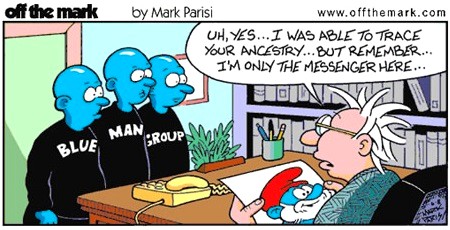 |
2) THE FRENCH CONNECTION BB member Richard Potetz has had a continuing interest in a possible French connection to Burgenland driven, reasonably, by the probable French origin of his surname. Within his family lore is the belief that his line descends from a soldier who came with a French army, settling in Burgenland prior to the start of accessible records (which, for most of Burgenland, is 1828, though that year should change when the Eisenstadt diocese completes digitization of their records, many of which go back much further). In Richard's case, he believes his Potetz name derives from a soldier named Potez who came in 1664 with the French army that fought at the Battle of Mogersdorf. Recently Richard mentioned a "DNA relative" of his, Austrian BB member Rainer Saurer, who "has a great family tree, all born in villages adjacent to Güssing with one exception, 4x grandfather Jean Vandame, surprisingly born in France." What, you may ask, is a "DNA relative"? This would be a person with whom you cannot connect to by conventional records-based genealogy but where you have identical segments of DNA of length well beyond the 7.0 cM threshold needed to statistically establish "identical by descent." So, the belief is that you are, indeed, relatives and that only the lack of records or the knowledge of sharing of DNA outside wedlock keeps you from making the connection. Richard wrote to me saying:
I replied: Hi Richard, I did a bit of studying on old maps and known battles
leading up to the Austrian surrender near Vienna (Wagram) in July 1809. It appears that
Napoleon’s forces congregated south of the Danube, crossing the Danube to the southeast of
Vienna, heading north. The French troops were there because they had come from a battle near
Regensburg and went southeast to Enns then east toward Vienna (the main Austrian army took a
more northerly route, ending up northeast of Vienna). Some of the French troops were sent down
to Graz but later headed north-northeast toward Vienna and Raab (Györ). Other French troops
headed directly toward Raab but then were recalled and joined Napoleon near Vienna. It seems
clear that the troops who attacked Graz and Raab (both in June 1809) had to pass through or near
Burgenland to get to Vienna, thus putting lots of French troops near or in Burgenland villages,
especially in the north. |
3) PROPER PEASANTS: FAMILY STRUCTURES 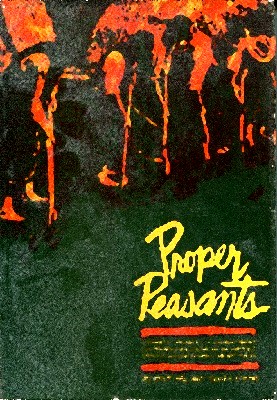 In
Newsletter No. 237 (November 30, 2013), Article 5, I
introduced the book "Proper Peasants: Traditional Life in a Hungarian Village" and
promised more articles drawn from the insights it presents. The authors were Edit Fél and Tamás
Hofer and it is their thoughts on peasant family structures that I'll try to distill into a
manageable size in this article. In
Newsletter No. 237 (November 30, 2013), Article 5, I
introduced the book "Proper Peasants: Traditional Life in a Hungarian Village" and
promised more articles drawn from the insights it presents. The authors were Edit Fél and Tamás
Hofer and it is their thoughts on peasant family structures that I'll try to distill into a
manageable size in this article.As I stated in the initial article about the book, my intention is to describe those details that might enlighten us on how our Burgenland ancestors lived and interacted with their fellow citizens. Even though the subject village is far from Burgenland, both Fritz Königshofer, who recommended the book to me, and I believe it has sufficient universal nature to make it applicable to Burgenland during its Hungarian time. Related to that, BB member Ginger McGurk once shared a postcard with the staff, asking for a translation of the handwritten message on the back. The front of the card (see below) shows a Hungarian family (relatives of Ginger's) that embodied the character of the time and place that was Burgenland under Hungarian rule. And the text of the message, when translated and then viewed through the perspective of Fél and Hofer's analysis of peasant family structures, is poignant. Before I get to Fél and Hofer's family structure analysis, I want to point out a few features apparent in the family image below (Note: while these 'features' are supported by the card's message and are consistent with Hungarian peasant family structure, please know that I am, nonetheless, making conjectures, not stating facts). First, note that the older lady has pride of place in the center of the photograph... yet the likely mother of the pictured children is relegated to a standing position at the edge of the photo. Also note that the older gentleman and the adult man (who likely is the father of the children and husband to the standing lady) are given almost equal positions seated next to the older lady; this despite the fact that the adult standing lady is almost certainly the daughter of the older couple (per Ginger's information) and the seated man is only a son-in-law. The eldest son anchors the other end, by his grandfather, and is attired in a seemingly new suit. 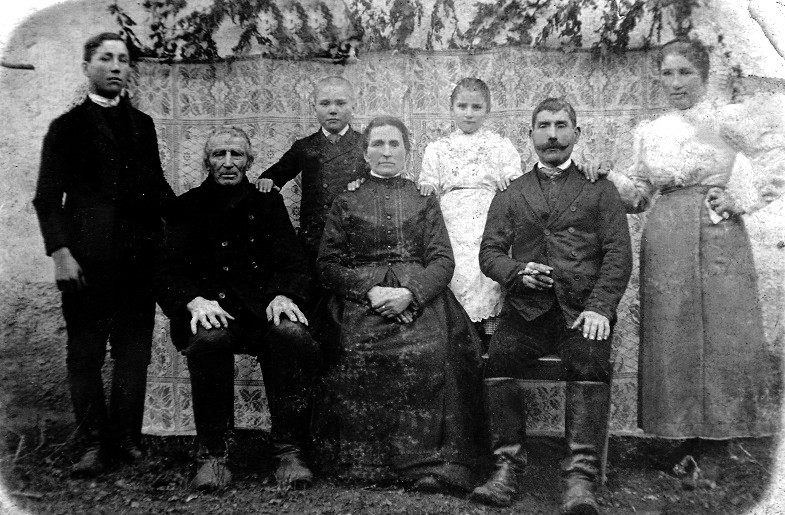 So why are the people arranged in this manner? Let me start with a little background information... according to Fél and Hofer, in the traditional Hungarian land-owning/farming household, the older people, men and women, retained authority in the household until death. However, it was generally desirable that one or more sons would "marry into the household" to insure maintenance of the family's economic base and provide a secure retirement for the parents. However, if no sons existed or did not "marry in" (for whatever reason), a daughter and her spouse were obliged to live with her parents; the vő (son-in-law), came into the household to provide manpower. Given the importance of family (család) in traditional Hungarian social life, this second situation (a vő coming in) was far less desirable for both the household's family and for the vő. The married-in vő was part of the háznép (household) but not the family. Fél and Hofer say that "Nobody wants to become a married-in vő. A young man is always forced to do so by circumstances or tempted by the 'desire for property'." In the preferred arrangement of one or more sons marrying in, the son's wife, the meny (daughter-in-law), would be brought to the house of his parents on the day of marriage along with her hope chest; no other noticeable change occurred in the house or household. In the alternative arrangement, if a son left his család before the death of his father to marry in elsewhere, the vő usually came into the new household with only his clothes and a hatchet, regardless of how rich his father was. His clothing was placed in his wife's hope chest and, like a meny, his coming induced no noticeable change in house or household. However, the future of the vő was often asssured by a contract with his wife's family that entitled him to payment of "the average wages of a hired man" for the duration of his marriage shoud he leave the household after the childless death of his wife or if he should be sent away. In the household, the head and ruler is usually the oldest man, the gazda (head of the family), and he is the owner of the family estate (more formally, a gazda is a peasant owning a farm that is sufficient to enable him to support his family without additional income). However, it is possible that a male child or a woman could be the gazda because of the death or military service of the putative gazda. Whoever is gazda, they have absolute authority over the household and its property, having final word on economic decisions and even marriages of members of the household, and control all family income. The gazda does the marketing, buying and selling its livestock and produce, even purchasing the clothing of household members. He/she has the place of honor at the dinner table, being first to eat, given the best pieces, and cutting and distributing bread to household members as he/she sees fit, and has the best sleeping place. However, the main share of the farm work also is his responsibility, leading the work, setting the pace, and helping the weaker workers. The position of gazda is maintained until death and no property is handed over until that time. However, after age 50 the gazda may assume a more "directorial" role, letting the hard labor be done by younger family members. Men (including boys from age 12), led by the gazda, spend most of the year (from early spring until late fall) living in the kert (the "farmyard," a fenced-in place, outside the village proper, containing a stable for horses, cattle and sheep, a cart shed and tool house, and a stack yard where stacks of hay, straw, or grain in sheaf are stored). The men are there to care for and guard the animals and crops and to be nearer the fields for farm duties. The men may return to the house in the evening for food but other meals are brought to the fields. A husband might share a marital bed with his wife only one or two nights a week; the rest were spent sleeping in the kert. [Side note: Joe Jarfas tells me that the more modern meaning of kert in the Szombathely area (where he was raised) is a fenced area around the house holding a vegetable garden, flowers and/or fruit trees, all being attended by the women of the household. The terms rétek (where animals were kept) and földek (where crops were grown) were used for the male domains and were the places where men lived much of the year. He later looked up 'kert' in his Hungarian etymological dictionary, which revealed a first mention of the word in print in 1055... having the current "garden" meaning. Only in the 13-1400s did it begin to have regional variations that encompassed the "farmyard" meaning used by Fél and Hofer in Átány.] Second in command is the gazdasszony (gazda + woman), the wife of the gazda. While the gazda bears the burden of the agricultural labor, the gazdasszony has that of the house and household. The gazda asks only what shall be eaten but it is the gazdasszony who has responsibility to provide the food and make ends meet. She has the right to know what is happening in the farm and fields, where the men are working and what they are doing, and she shares with her husband any problems with household members or expenses. She has the next-most honored position in the household, sitting beside her husband at the table and sharing his bed. When meny-s are in the household, her precedence is emphasized by her right to cook and bake (her sense of self-worth is tied to being able to do these things); the others are merely helpers in these tasks. It is also her right and duty to carve the meat at table and to allot shares as she sees fit; likewise to allot food for field lunches. She is the keeper of the family purse, with all cash within the family entrusted to her care. When the gazda needs money, he gets it from her and then provides an exact account of what was spent; likewise, any cash earned by a sale of family property is reported to her and the cash turned over to her for safekeeping. However, she keeps two different accounts. Proceeds from the sale of livestock, grain, etc. constituted the "tőke" (capital), the money for farm expenses. Only the gazda can spend this money. Money for expenses of the house (supplies, lamp oil, clothing for her and her daughters, tobacco for the men, even spending money for bachelor sons) must be raised by her by selling poultry, milk, bread, linen, etc. Suits and boots for men may be paid from tőke money, but female attire never. In order to build the trousseau of daughters, geese are raised by the gazdasszony for the eiderdown for a featherbed and hemp is grown to be woven into linen; the goal being to have enough linens in the trousseau to last the daughter's lifetime. As for food, typically a 300-400 pound pig, taken from the family stock (kept in the house yard at night but sent out to pasture daily with a swineherd), is expected to feed a family of four for a year. Grain for bread is also supplied by the farm fields and milk is from the family cows (milked by the women). All other foods are raised or grown under the guidance of the gazdasszony and she must assure it all stretches the full year. As for grown sons and daughters, and especially meny-s and vő-s, they do what they are told and have no real influence in decision-making. Inheritances only occur on the death of the gazda, so there may be many years of effective servitude before a reward comes. However, it is the gazda's responsibility to preserve and improve the estate and never to sell inherited property (purchased property can be ethically sold). Daughters (and meny-s) are expected to milk the cows, assist in hoeing the fields in the summer, and do household labors under the direction of the gazdasszony. Sons and vő-s take care of the livestock, plant, attend and harvest the crops, and work with the draft animals, per the wishes of the gazda. Younger sons and daughters (especially sons, as they can carry on the family name) are what Fél and Hofer call "the ornaments of the house" and are raised by the mother and grandparents. At six years of age they become school children, which they attend for six years. Upon leaving school, a girl is considered "eladó" (marriageable), however a boy is merely considered "suttyó" (a youth). He moves to the kert where he is slowly taught the art of farming. When he grows older and stronger, he may work on the farm or be sent off to work as a swineherd, shepherd or day laborer. While there is pride in "being given orders only by one's father," life as a worker elsewhere was often easier, as you only had to do what you were hired for, as opposed to whatever your father dreamed up. A boy may start his farming career by hoeing crops but reaping was considered "the real work of men." Only when the art of reaping was learned, usually at age 16 or 17, could a boy be considered a full-fledged worker. Even then, he had to pass the test of keeping up with a team of trained havesters before he was considered a man. Success at that graduated him to the life of a bachelor, a scythe man, where he was allowed to smoke in public and serve himself at table. He was also given a good suit, new boots and spending money, and began a short, irresponsible (but condoned) period of life known as the "bachelor's life." Bachelor life meant roaming every night with other bachelors... dancing, drinking and brawling. While some work was done to support this lifestyle, little thought was given to his family or its economic welfare. Even more so, depending on his mother—or a little minor in-family theft—to support his lifestyle was not uncommon. However, the bachelor's life ended at age 18 when a two-to-three-year period of military service began. Upon return from service, getting married and starting adult life became the goal and bachelorhood was no longer condoned. Upon completion of their school years, girls worked in the house, attending the younger children, doing chores, and preparing their trousseaus, and they hoed in the fields in the summer. They were not taught to cook (as that was the duty of older women). At age fourteen they begin to receive suitors and were expected to be married by age seventeen or eighteen. By age twenty, an unmarried girl was regarded as an "old maid" and was expected to sit in the "spinster's pew" in church. They lost the right to choose their own husband and were actively "marketed" by their family in an effort to "give them out of the house." So this brings us back to the picture above and my question as to "why are the people arranged in this manner?" Pictures were considered part of household life, not of agricultural endeavors, so fell under the control of the gazdasszony. As such, given her place of honor in the house, she was also given place of honor in the picture, seated upfront and center. Her husband, the gazda, was placed to her right, also seated. The only surprise is that the vő was also given a place of honor, seated beside his mother-in-law. This was driven, in part, by the fact that he was male (and males were clearly considered more valuable and honor-deserving than females in the Hungarian village society and families). However, it also strongly suggests a few other things. First, as a vő, he must have somehow endeared himself to the family, becoming accepted more as "son" than "son-in-law" (if not, the eldest grandson might have been afforded the more honorable, seated position). Second, from the picture, it seems that the gazda himself was no longer strong (especially in comparison to his wife), so likely had ceded some family leadership to his son-in-law and eventual heir. Likewise, the difference in footwear between gazda and son-in-law suggests the same; the gazda no longer wears the boots of a working man. Even the fact that the vő is holding a cigar, a sign of manliness during that time, while his father-in-law is not, suggests a higher-than-expected status in the family. As for his wife, slightly behind and to the left was considered the proper place for a wife when walking in the village. To echo that in the picture was quite understandable. Even more so, her place on the edge of the family also echoes her relatively-low current status in her peasant family structure and home. As for the eldest son/grandson and his new suit, it seems likely that he had entered his bachelor life, still young but regarded as a man and allowed to be up front with the other adults. (Nonetheless, his facial expression suggests he might be happier out carousing with his friends!) Placing the younger children in the background was also consistent with their place in village and family society and their difference from their elder "bachelor" brother. Thus there is much about this picture that is consistent with what Fél and Hofer tell us about family structures in Hungarian peasant villages of the late 19th and early 20th centuries. Having read their book, the picture said so much more to me than it might have done otherwise. Again, I recommend the book to you if you are interested in increasing your understanding of our Austro-Hungarian roots. |
4) PHOTO IDENTIFICATIONS NEEDED - RESPONSE Last month, Connie Shield shared some photographs found among the belongings of her grandparents, Joseph and Rosa (Grabner) Steiff, who respectively were born in Königsdorf in ~1887 and Limbach im Burgenland in ~1893, emigrated in 1912 and 1913, and married in Allentown, PA, in 1916. Connie wanted assistance in placing the photographs and identifying any of the individuals shown. We received a response concerning this picture: 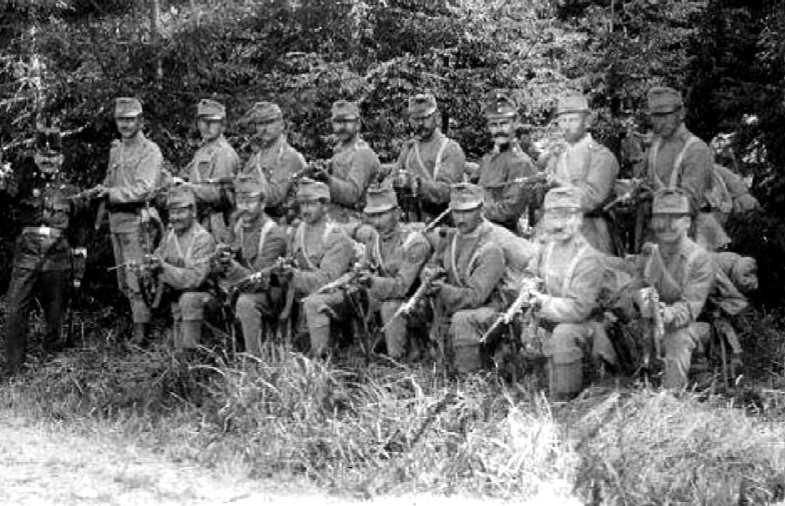 From Terry Grogan (via Ron Markland): "This photo looks to be from the First World War era. My best guess at the date the photo was taken would be Fall of 1914 – or Spring of 1915 – with the Autumn of 1914 being more likely. I say this because of the rifles they are using and the lack of any military medals in a group of that size. There are also no puttees being used as leggings. Note: By 1915, most units had individuals with military medals – or at least one of the so-called “Kappenabzeichen” (Ed: cap badges/insignia) for the different Armies on their field caps. "By their age – I would also be more inclined to say this was from a Landsturm unit – although they could still be Landwehr." The term Landsturm was historically used to refer to militia or military units comprised of troops of inferior quality. During the First World War, the Austro-Hungarian Landsturm consisted of men aged 34 to 55 who belonged to the Austrian k.k. Landsturm and the Hungarian k.u. Landsturm. The Landsturm formed 40 regiments totaling 136 battalions in Austria and 32 regiments totaling 97 battalions in Hungary. The Landsturm was a reserve force intended to provide replacements for the front line units. The Austrian Landwehr was one of three components that made up the ground forces of the Austro-Hungarian Dual Monarchy between 1868 and 1918, and it was composed of recruits from the Cisleithanian parts of the empire. Intended as a national defence force alongside the Royal Hungarian Landwehr (or Hungarian Honvéd), the Landwehr was established 5 December 1868. At the start of the First World War, Landwehr units were considered equal to the units of the Common Army in readiness and equipment. The Austrian Landwehr and the other components of the Austro-Hungarian Army were all full-time standing armies. The Common Army (Gemeinsame Armee) was the largest part of the Austro-Hungarian land forces from 1867 to 1914. The Common Army formed the main element of the "armed power" (Bewaffneten Macht or Wehrmacht) of the dual monarchy, to which the Imperial and Royal Navy (k.u.k. Kriegsmarine) also belonged. So, what were the military units in or near Burgenland in 1914? Wikipedia provides a comprehensive list for the Austro-Hungarian Army, from which I extracted the following and translated to English. These should be the only units close to current-day Burgenland. Bruck an der Leitha Bosnian-Herzegovinian Military Police Battalion Köszeg - Güns III. Battalion, Infantry Regiment 83 Nezsider - Neusiedl am See I. Division, Hussars Regiment 3 Ödenburg - Sopron 28. Infantry Brigade Staff, II. Division, Hussars Regiment 3 Staff III., IV. Battalion, Infantry Regiment 48 I. Battalion, Infantry Regiment 76 k.u. Honvéd Infantry Regiment 18 Field Cannon, Regiment 13 II. Battalion, Telegraph Regiment Pozsony - Pressburg - Bratislava V. Army Corps 2. Cavalry Troops Division 14. Infantry Troops Division IV. k.u. Landwehr District Headquarters 73. k.u. Honvéd Infantry Brigade 27. Infantry Brigade IV. Battalion, Infantry Regiment 71 Staff, I., III., IV. Battalion, Infantry Regiment 72 k.u. Honvéd Infantry Regiment 13 Field Cannon Regiment 14 Field Howitzer Regiment 5 Training Division 5 Pioneer Battalion 5 Szombathely - Steinamanger Ulanen (Lancers) Regiment 5 II. Battalion, Infantry Regiment 83 Wiener Neustadt Ulanen (Lancers) Regiment 4 II. Battalion, Bosnian-Herzegovinian Infantry Regiment 1 Field Cannon Regiment 6 I also looked for information on Landsturm unit designations but could find only very limited information, that being Landsturmbezirkkommandos (Landsturm district commands - headquarters?) for years 1904 and 1908. These are the towns near Burgenland, but what the numbers mean was not stated: Pozsony - 40, 41, 42 Rozsahegy - 49 Sopron - 57, 58 Köszeg - 59 Körmend - 66 |
5) TORONTO'S HUNGARIANS AND BURGENLÄNDERS Over the last few years, Margaret Kaiser has shared Toronto-based newspaper articles with me about the ongoing demise of ethnic-Hungarian businesses in Toronto, particularly restaurants. These businesses were in the so-called Goulash Archipelago, the Bloor Street West strip in Toronto colonized by refugees from the 1956 Hungarian uprising (see longer red underline in map below). 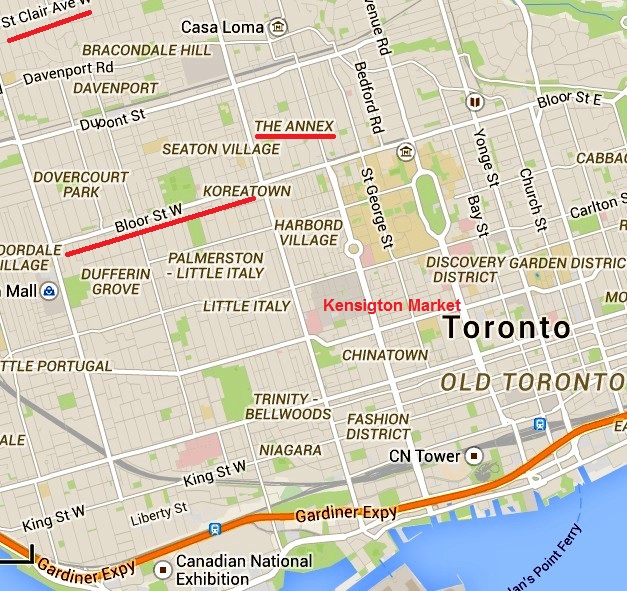 This
"Goulash Archipelago" came into being after the October 1956 uprising in Hungary, which quickly
brought 37,000 Magyar refugees to Canada some 58 years ago. The Canadian immigration minister
had announced in late November 1956 that Canada would pay the transportation cost for refugees
coming to Canada. By January 1957, refugees were pouring in at such a pace that the program was
cancelled in March. Overall, some 100,000 Hungarian refugees made their way to Canada. Although
no records were kept on how many Hungarians ended up in Toronto, Susan Papp, historian at the
University of Toronto and adjunct scholar for the Multicultural History Society of Ontario, says
"Toronto and Montreal received the most Hungarians, probably equal amounts." This
"Goulash Archipelago" came into being after the October 1956 uprising in Hungary, which quickly
brought 37,000 Magyar refugees to Canada some 58 years ago. The Canadian immigration minister
had announced in late November 1956 that Canada would pay the transportation cost for refugees
coming to Canada. By January 1957, refugees were pouring in at such a pace that the program was
cancelled in March. Overall, some 100,000 Hungarian refugees made their way to Canada. Although
no records were kept on how many Hungarians ended up in Toronto, Susan Papp, historian at the
University of Toronto and adjunct scholar for the Multicultural History Society of Ontario, says
"Toronto and Montreal received the most Hungarians, probably equal amounts."A 2009 census reported that about 53,000 Torontonians were of Hungarian birth or descent, and the 2006 Canadian census shows that about 1% of the 32 million Canadians report sole (89,000) or partial (227,000) Hungarian ethnicity (a ratio that indicates a high level of current integration into the wider Canadian society). Among our Burgenland Bunch surnames, there are 35 mentions of Toronto as destination for ancestors, so we have some representation there also. However, all but one of those surname entries indicate a Burgenland, rather than a post-1921 Hungarian village of origin, and none indicate an approximate 1956 emigration date, suggesting our member's families were not "uprising" refugee emigrants to Toronto. Perhaps they were among those "Hungarians" who helped welcome and integrate the refugees into their new home through their ethnic organizations such as the Hungarian Canadian Cultural Centre, then located near where the refugees first settled (but now on St. Clair Avenue, a dozen blocks north of Bloor Street). Many of the '56 refugees originally settled in the Kensington Market area of Toronto (marked in red in the map above). Some 65 per cent were Roman Catholics and went to the St. Elizabeth of Hungary Church in the southeast corner of that area (now the site of a Chinese mall). However, they quickly drifted north toward Bloor St. to set up their businesses and moved further north into the Annex area to set roots. Of these Goulash Archipelago businesses, restaurants dominated, with over a dozen ethnic-Hungarian restaurants and coffee shops dominating the strip. But there were also ethnic-Hungarian stores and meat markets, doctors and druggists, hairstylists and barbers; all conversant in Hungarian and providing a bit of home so far away. However, according to the Toronto Star News, only one ethnic-Hungarian restaurant (Country Style) survives on the Bloor Street strip. The others closed because of rapidly increasing rents, a decline in business as subsequent generations became integrated into Canadian society and moved elsewhere in Toronto, or a lack of interest by the owner's children in taking on a labor-intensive and hours-eating business. The Torontoist blog recently ran an article showing some of the old advertisements of the Hungarian restaurants and naming various ones: Jack and Jill, The Coffee Mill, Marika’s, Cake Master, Corona, Country Style, the Blue Danube Room, Hungarian Village, Woodenplate Hungarian Dining Room, and Csárda's. The Star News named more: Tarogato, Continental, Korona, Sport, Duna Corzo, Hungarian Castle, Master Chef, Little Europe and Emke. 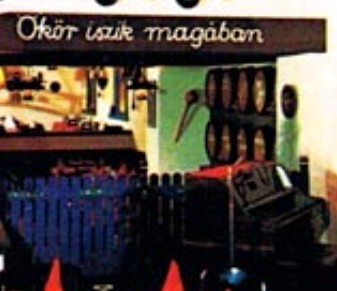 One
ad that caught my eye was the one for the now-extinct Csárda restaurant, mostly because
it had an interesting slogan on a beam above its musical stage area. To the right is a blowup of
that part of the image. The text reads "Ökör iszik magában" and (questionable) Google
Translate translations are "Ox drinks alone" or "Ox toasts himself." This, of course,
baffled me so I resorted to my buddy Joe Jarfas to set me straight. He explained that "the
true meaning of the expression is: (Only) an ox drinks by himself. So if you don't want be
categorized as an ox (antisocial) you share your drink with others (especially wine)." Now
that is a sentiment I can agree with and I can fully understand why it was posted in a convivial
full-service dining establishment! One
ad that caught my eye was the one for the now-extinct Csárda restaurant, mostly because
it had an interesting slogan on a beam above its musical stage area. To the right is a blowup of
that part of the image. The text reads "Ökör iszik magában" and (questionable) Google
Translate translations are "Ox drinks alone" or "Ox toasts himself." This, of course,
baffled me so I resorted to my buddy Joe Jarfas to set me straight. He explained that "the
true meaning of the expression is: (Only) an ox drinks by himself. So if you don't want be
categorized as an ox (antisocial) you share your drink with others (especially wine)." Now
that is a sentiment I can agree with and I can fully understand why it was posted in a convivial
full-service dining establishment!Joe also provided a different interpretation of the slogan (one prompted by the other possible translation I threw at Joe that included the word "toast"). He said "And this leads back to 'toast' being the trust of not getting a poisoned drink. In olden times, wine with its sediment was often used to poison somebody (poison well-hidden in settlement). The Lord of the house, though, would take a small amount and drink it first - to prove the drink is safe. But when he offered his glass to a guest to pour a little of his wine in there, if the guest trusted him he would just touch his glass to the host's to let him know he trusts him ... and that's how toast became a gesture of trust." My thanks to Joe for enlightening me (yet again) so I could share it with you. Rather than just 'rewrite' the articles that Margaret shared and that served as inspiration for this article, I will list them below and let you read them firsthand. I also include some additional sources for facts reported herein: - The Star News: Goulash Archipelago - The Star News: Country Style, The Last Hungarian Restaurant Standing - Torontoist Blog: Vintage Toronto Ads: A Taste of Hungary - Heritage Toronto: Toronto's Hungarian Community - Wikipedia: Hungarian Canadians - Wikipedia: Ethnic Origins of People in Canada |
6) HISTORICAL BB NEWSLETTER ARTICLES Editor: This is part of our series designed to recycle interesting articles from the BB Newsletters of 10 years ago. However, I did not find anything of compelling interest in the March 2005 edition so I looked back further, this time to March 15, 1999 and issue #53A, where I found an article concerning church records for three (primarily Lutheran) villages. Since I have just completed the bulk of a project to provide names for all the Burgenland churches, this topic was of interest to me; I hope it is for you too! THE BURGENLAND BUNCH NEWS - No. 53A March 15, 1999 QUESTIONS CONCERNING ZAHLING-ELTENDORF-KUKMIRN CHURCH RECORDS (SOUTHERN BURGENLAND) (correspondence between Vicky Wenninger, Fritz Königshofer, and Gerry Berghold) Question: What happened in 1879? Did Eltendorf obtain its own Lutheran parish? If so, is it possible that there were three Lutheran parishes, namely Eltendorf, Zahling and Kukmirn, within a short distance of each other? Did some people of Zahling report to the Lutheran parish in Kukmirn? Anyway, the one point I cannot understand is why Kukmirn could serve Eltendorf (even if only until 1879) when there was a much closer place for the Eltendorf Lutherans in the form of the parish in Zahling. As for Roman Catholics, to your knowledge, did all people from Zahling register their vital events in Königsdorf, or is it possible that some reported to the RC parishes of Kukmirn or Heiligenkreuz? Answer: The confusion concerning these villages is that at one time or another their churches were all attended by nearby Lutheran and Catholic inhabitants. Secondly, Zahling was a much larger village at one time than it is today (1852: 694 pop., 1890: 1001, 1946: 648, 1991: 433). Kukmirn has had both a Lutheran church and a Catholic church, Eltendorf has only a Lutheran church; Königsdorf and Heiligenkreuz have only a Catholic church. Zahling and Poppendorf have no church, only small Catholic chapels. All of these villages have had a Lutheran "Betthaus" [prayer house] if they didn't have a Lutheran church. 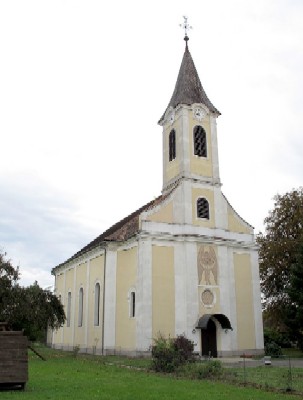 Zahling
was, at one time, the Lutheran headquarters for southern Burgenland (pre-1780's). The Eltendorf
Martin Luther Kirche was built in 1783 following the 1781 Edict of Toleration, but
the church has Lutheran records from 1770, since pre-1783 services were held in "Betthausen"
in Königsdorf, Poppendorf and Eltendorf, I believe). In the 1500's (Reformation), the Lutheran
center was Güssing (until 1684). It was then transferred to Zahling when the Batthyány family
[in Güssing] switched back to the Catholic faith. Zahling had a very early connection with the
Lutheran faith as well as an old Lutheran school, which is currently being restored, which may
have accounted for its importance in matters Lutheran, but there was also an important Lutheran
school in Königsdorf. The center was later switched to Eltendorf (see history extract below).
The Zahling church is old but small and, as a result, the Lutherans (579 in 1873, the date of
the Gazetteer I use) attended the Lutheran Church in Kukmirn. The 352 RC's went to church
in Königsdorf, which was closer than Kukmirn. Zahling Lutherans started to attend the Eltendorf
church in 1936. Some may still attend Kukmirn. I also know that children went to school partly
in Kukmirn, partly in Eltendorf and partly in the Catholic school in Zahling. Confusing, to say
the least. Zahling
was, at one time, the Lutheran headquarters for southern Burgenland (pre-1780's). The Eltendorf
Martin Luther Kirche was built in 1783 following the 1781 Edict of Toleration, but
the church has Lutheran records from 1770, since pre-1783 services were held in "Betthausen"
in Königsdorf, Poppendorf and Eltendorf, I believe). In the 1500's (Reformation), the Lutheran
center was Güssing (until 1684). It was then transferred to Zahling when the Batthyány family
[in Güssing] switched back to the Catholic faith. Zahling had a very early connection with the
Lutheran faith as well as an old Lutheran school, which is currently being restored, which may
have accounted for its importance in matters Lutheran, but there was also an important Lutheran
school in Königsdorf. The center was later switched to Eltendorf (see history extract below).
The Zahling church is old but small and, as a result, the Lutherans (579 in 1873, the date of
the Gazetteer I use) attended the Lutheran Church in Kukmirn. The 352 RC's went to church
in Königsdorf, which was closer than Kukmirn. Zahling Lutherans started to attend the Eltendorf
church in 1936. Some may still attend Kukmirn. I also know that children went to school partly
in Kukmirn, partly in Eltendorf and partly in the Catholic school in Zahling. Confusing, to say
the least.I have a book titled "200 Jahre Evangelische Pfarrgemeinde A. B. Eltendorf." This was issued in 1983 and carries the dates 1783-1983. Page 21: "Die Komitatsbehrden erteilten erst auf Grund besonderer Ansuchung und etlicher Kommissionierungen im Jahre 1783 die Erlaubnis, das sich die Evangelischen von Eltendorf, Königsdorf, Rudersdorf, Poppendorf, Heiligenkreuz, Raabfidisch, Oberradling, Unterradling, Güssing, Neuhaus am Klausenbach, Tauka, Liebau, Minihof, Mühlgraben, und Krottendorf zu einer Pfarrgemeinde zusammenschliessen dürfen, als deren Sitz Eltendorf bestimmt wurde. Schon die Wahl des Pfarrortes zeigt, dass zu den Einrichtungen der Reformationszeit keine organisierte Kontinuitt bestand. Vermutlich war es die zentrale Lage, möglicherweise aber auch das Fehlen einer katholischen Pfarre, die zusammen mit einer entsprechenden Anzahl von Familien (der Ort war fast zur Gänze evangelisch) die Ursache war, dass sich in Eltendorf die Gemeinde sammelte." [= The county authorities granted permission in 1783 only on the basis of a specific request and several commissionings, by which the Protestants of Eltendorf, Königsdorf, Rudersdorf, Poppendorf, Heiligenkreuz, Raabfidisch, Oberradling, Unterradling, Güssing, Neuhaus am Klausenbach, Tauka, Liebau, Minihof, Mühlgraben, and Krottendorf may merge into a parish with Eltendorf established as the seat. Even the choice of the parish village shows that, [despite] the institutions of the Reformation, there was no organized continuity. It was probably the central location, but possibly also the lack of a Catholic parish (the place was almost entirely Protestant), that, together with a corresponding number of families, was the reason that Eltendorf gathered the congregation. Not until 1939 did the daughter churches today in Zahling and Neustift / Güssing belong to our parish.] (This establishes Eltendorf as a Lutheran center with the establishment of their new church.) I find no significance in the date 1879. Eltendorf's Martin Luther Kirche was already almost 100 years old by that time. My history cites Eltendorf's "Unsere Tochter" ("our daughters" - affiliated Evangelical villages) as Heiligenkreuz (no date given [but 1783]), Königsdorf (1783), Neustift (from Kukmirn to Eltendorf [in 1939]), Poppendorf (1783), (Lutherans bought a Gasthaus in 1800's for a "Betthaus"), and Zahling [in 1939]. (Auch hier hatte der Protestantismus bereits Mitte des 16. Jahrhunderts Fuss gefasst. = Here too, Protestantism had already formed a foothold by mid-16th century.) The village belonged to the parishes of Königsdorf, then Kukmirn and today to Eltendorf. The Kirchenvisitationsprotokoll of 27 Feb 1787 lists "Mutttergemeinde [mother community]" Eltendorf, "Filiale Gemeinden [branch communities]" Fidisch (sic), Ruttersdorf (sic), Heiligenkreuz, Poppendorf, Nemeth Ujvar (sic) - Güssing. (note Zahling is missing, at which time it must have belonged to Kukmirn [it did]). From all of this, I would again suggest that members researching ancestors from this area should search the following church records: Eltendorf Catholics-Königsdorf Lutherans-Eltendorf Heiligenkreuz Catholics-Heiligenkreuz Lutherans-Eltendorf Königsdorf Catholics-Königsdorf Lutherans-Eltendorf Poppendorf Catholics-Heiligenkreuz Lutherans-Eltendorf Zahling Catholics-Königsdorf, Kukmirn Lutherans-Kukmirn, Eltendorf Fritz adds: The Lutheran records for the Kukmirn parish are on four films (0700678-81). The Lutheran records for the Eltendorf parish are on three films (0700737-39). The Roman Catholic records for the Königsdorf parish are on two rolls (0700675-76). The Roman Catholic records for the Kukmirn parish are on one roll, namely 0700677. The Roman Catholic records for the Heiligenkreuz parish are on one roll, namely 0700718. All these Lutheran and Catholic records are the so-called duplicates that cover the period 1828 till September 1895. The civil records for Eltendorf cover the time from October 1895 to 1920, include all denominations, and are on five rolls (0700435-39). [Ed: Images of the civil record pages are also available online on the FamilySearch.org website for browsing there.] Considering the many inter-village marriages, I'd search them all. My reading of the village lists (Albert's) shows Zahling RC to Königsdorf only and LU to Eltendorf only but these lists were compiled in 1970 and reflect the current status (as of 1970). They have changed more than once as reflected by the entries in my 1873 gazetteer. I might mention that the LDS also had considerable confusion concerning Zahling and Eltendorf in that that they had no entry for Eltendorf! Took me a year to find that they were listed under Zahling (Czahling). I wrote to then and they corrected their index. Their problem had to do with the reading of "Kortvelyes" - Hungarian for Eltendorf, as being the same as "Kis Kortvelyes" - Hungarian for Zahling, but many of the Hungarian records carried "Zahling" titles even though the data was from Martin Luther Kirche in Eltendorf. A mystery which might be explained by a confused copyist. Checking the latest Zahling history, I find that from 1653-1671, Zahling Lutherans belonged to Königsdorf. This was, of course, when the Catholic church was taken over by Lutherans who were then suppressed until the Edict of Toleration. In 1783, Zahling became a "Tochtergemeinde" of Kukmirn, where a new Lutheran church had been built. It also says that, in 1936, they joined Eltendorf, to which they still belong. Population is now about split RC vs Evang. - slightly more Evang. RC data - The very old Zahling church (13th century) has a bell dated 1404. In a canonical visitation of 1557, Zahling is described as the mother church of Königsdorf parish! It is now (no date given) a "Filialgemeinde" of the parish of Königsdorf. Kukmirn is not mentioned in this respect. Ed. note (2015): Two online resources for understanding the current relationships among Burgenland parishes and churches are the following. Do note that the websites are presented in German... but Google Translate can help decipher them: Lutheran Superindendency: http://evangnet.at/cms/front_content.php?idcat=38 Catholic Diocese: http://www.martinus.at/adressbuch/gruppe/2131120131654051.html |
7) ETHNIC EVENTS LEHIGH VALLEY, PA Saturday, April 11: "Ein Abend in Wien" at the Lancaster Liederkranz. Music by the Walt Groller Orchestra. Info. www.lancasterliederkranz.com Saturday, April 18: 66th Stiftungsfest of the GTV Edelweiss Schuhplattlers at the Reading Liederkranz. Music by John & John. Info: www.readingliederkranz.com Sunday, April 19: Spring Concert & Dance at the Reading Liederkranz. Entertainment by the Reading Liederkranz Singers, guest choruses, and the Joe Weber Trio. Info: www.readingliederkranz.com Sunday, April 19: Viennese Concert & Ball at Sunnybrook Ballroom in Pottstown. Music by the Main Line Symphony and the Walt Groller Orchestra. Info: www.vienneseconcert.com Saturday, April 25: Spring Concert & Dance at the Lancaster Liederkranz. Entertainment by the Lancaster Liederkranz Chorus and Die Immergrün Musikanten. Info: www.lancasterliederkranz.com NEW BRITAIN, CT Friday, April 3, 7 pm: Heimat Abend. Austrian Donau Club, 545 Arch Street, $3. Music by Joe Rogers and his band. Friday, April 17, 7:30 pm: Heurigan Abend. Austrian Donau Club, 545 Arch Street, $3. Music by Schachtelgebirger Musikanten. |
8) BURGENLAND EMIGRANT OBITUARIES Adolph Laschober  Adolph
Laschober, 91, of Jerseyville, Missouri, died Saturday, Feb. 28, 2015, at Jersey Community
Hospital in Jerseyville. Adolph
Laschober, 91, of Jerseyville, Missouri, died Saturday, Feb. 28, 2015, at Jersey Community
Hospital in Jerseyville.He was born on Oct. 14, 1923, in Holzschlag, Burgenland, Austria, one of three children born to the late Adolf and Anna (Sauer) Laschober. Al grew up in South St. Louis, where he graduated from Roosevelt High School before joining the United States Army, where he served our country honorably in World War II. After returning from the service, he returned to St. Louis, where he married the former Alta Kuhlmann in 1947, and the two made their home in Overland, Mo., where they raised their four children. Al worked at a bakery in South St. Louis for a short time before he began working alongside his father at Kilgen Organ Company, and later went on to work for McDonnell-Douglas where he retired in 1985 after nearly 25 years of service. He later met the former Helen (Green) Jett at a Single's Square Dance Group and the two would marry on Oct. 14, 1978, at the Trinity Lutheran Church in St. Ann, Mo., where they made their home for many years before relocating to Bethalto in 2006. Together they were blessed with 31 years of marriage before her passing on July 7, 2010. A carpenter by trade, Al enjoyed woodworking and sharing his creations with those he loved. He and Helen also enjoyed traveling, and did so extensively. One of their fondest traveling memories comes from the trip they took with Al's brother and sister-in-law back to where they grew up in Austria. Al was a wonderful family man and will be most remembered for his great sense of humor and his zest for life – always proclaiming "I had a good life." Surviving are a son, Gene Laschober of Kirkwood, Mo.; three daughters, Barbara Harper of St. Louis, Deborah, and her husband, Bill Thompson of Peavely, Mo., and Donna Reedy of Ferguson, Mo.; three stepsons and their spouses, Thomas and Mary Jett of Hannibal, Mo., Everett "Lou" and Barbara Jett of Bethalto and Andrew Jett of Dallas, Texas; a stepdaughter and son-in-law, Cindy and Dick Zumwalt of Jerseyville; 15 grandchildren and 21 great-grandchildren. In addition to his parents and his wife Helen, he was preceded in death by his first wife and mother of his children, Alta Laschober; a brother and sister-in-law, Walter and Virginia Laschober, and a sister, Ann Mager. Visitation will be from 10 a.m. until time of funeral services at 1 p.m., Saturday, March 7, 2015, at the Crawford Funeral Home in Jerseyville with the Rev. G. Robert Heimgartner officiating. Burial will take place at the Oak Grove Cemetery in Jerseyville, with full military honors conducted by the Jerseyville American Legion Post 492 Color Guard. Memorials may be given to the Missouri Synod in care of the Funeral Home. The family would also like to extend a special "Thank You" to the nurses and staff at Jerseyville Nursing & Rehabilitation Center, for the tremendous care and compassion shown to Al and their family during his time there. Published in The Telegraph from Mar. 3 to Mar. 5, 2015 Cecelia Fruhwirth (née Missbüchler)  Cecelia
Fruhwirth, 94, formerly of Allentown, Pennsylvania, passed away Saturday. January 10, 2015 in
Whitehall Manor, Whitehall, Pennsylvania. Cecelia
Fruhwirth, 94, formerly of Allentown, Pennsylvania, passed away Saturday. January 10, 2015 in
Whitehall Manor, Whitehall, Pennsylvania.She was married to the late Stephen J. Fruhwirth. Born in Königsdorf, Austria, she was the daughter of the late Joseph and Anna (Mayer) Missbüchler. She was a seamstress for Top Hat Formal Wear, Whitehall for many years. She was a member of St. Francis of Assisi Catholic Church, Allentown. For decades, she was a volunteer in the Sacred Heart Hospital gift shop. Survivors: Daughter, Kathleen, wife of David Barlett of Whithall; daughter-in-law, Mary Louise Fruhwirth of Florida; 4 grandchildren; 6 great-grandchildren. She was preceded in death by a son, Dennis, a brother and a sister. Services: Private. Contributions: In lieu of flowers, memorial contributions can be made payable to American Parkinson Disease Association c/o the Robert A. Hauke Funeral Home, 327 Chestnut St., Coplay, PA 18037. Published online on January 10, 2015 courtesy of Robert A. Hauke Funeral Home, Inc. Margaret Roma (née Urban)  Margaret
Roma, 80, of Allentown, Pennsylvania, passed away on March 8, 2015. Margaret
Roma, 80, of Allentown, Pennsylvania, passed away on March 8, 2015.She was the wife of the late Peter Francis Roma. Born in Rábafüzes (Raabfidisch), Hungary, she was a daughter of the late Eduard and Gisela (Stanko) Urban. She was a waitress at the Austrian-Hungarian Veteran's Society for over 30 years, and a member of the Austrian-Hungarian Ladies' Auxiliary. Survivors: Sons, Peter Roma and wife Jocelyn, David Roma and wife Carol, and Edward Roma and wife Mary Jo; sister, Elfriede Seibert; grandchildren, Dominic Roma, Elissa Pape, Nicholas Roma, and Jacob Roma; great-grandchildren, Blake and McKenzie; nieces; nephews; and many other loving family and friends. She was also predeceased by a sister, Gisela Lutzenberger. Services: Viewing Thursday, March 12, 8:30-9:30am at Weber Funeral Home, 1619 W. Hamilton St., Allentown. Mass of Christian Burial 10:00am at Sacred Heart Catholic Church, 336 N. 4th St., Allentown, PA 18102. Interment at Sacred Heart Cemetery to follow. www.weberfuneralhomes.com Contributions: In lieu of flowers please give to the church, or to the American Diabetes Association at www.diabetes.org. Published in Morning Call on Mar. 11, 2015 Stephanie Walters (née Holzmann)  Stephanie
Walters, 103, of Old Saybrook, Connecticut, passed away Friday evening, March 20, 2015 at The
Weiss Hospice Unit, Middlesex Hospital. Stephanie
Walters, 103, of Old Saybrook, Connecticut, passed away Friday evening, March 20, 2015 at The
Weiss Hospice Unit, Middlesex Hospital.Steffie was born on Christmas Eve, Dec. 24th, 1911 to Karl and Franciska (Zieger) Holzmann, the 2nd of 5 children in the small village of Minihof-Liebau, Burgenland, Austria. It was here that Steffie began her passion for great food and cooking helping out in the kitchen in her parents prosperous Gasthaus at a very young age. Steffie's adventurous spirit brought her to America prior to WWII, the only member of her immediate family to do so. Settling first in Wichita, Kansas with a close aunt and uncle, she found the climate and landscape not to her liking and went on to settle in New Britain, CT where there was a large population from her native Burgenland. Soon after arriving she met the love of her life and true soul mate Edward Walters, and they married in 1938. Steffie and her husband shared a work ethic like no other and soon purchased a store front on Dwight St. turning it into The East Side Restaurant. Starting as a two man operation with Steffie doing the waitressing and all the cooking and Eddie tending bar and maintenance it soon grew and became the mecca in Connecticut for excellent German food. In 1956, the couple decided to try something new and moved to Old Saybrook and opened "Steffie and Eddie's Dock and Dine Restaurant", a seasonal restaurant that was to become a shoreline landmark for locals, summer residents, and visitors alike. They owned and operated this exceptional establishment with Steffie in the kitchen every day until it was sold in 1969 with the passing of her husband. Being the strong, independent spirit she was, sitting still was not in her genes. She took on the task of building a miniature golf course on the property adjacent to the restaurant. It was an idea she and her husband toyed with before his passing and became a reality in 1971. For her it was a hands on operation and each day was spent alongside her teenage employees greeting customers, tending the flower beds she prided herself on, and even sweeping the greens. Her generous nature showed through here as she gave away many free passes daily to youngsters who wanted to play but didn't have enough money. In 1989 Steffie decided that at 79 it was time to put work behind and have some fun. The property was sold to the town of Old Saybrook for all its residents to enjoy this unique setting at the mouth of the Connecticut River. Steffie loved her hometown of Old Saybrook for 59 years and never once uttered a word to demean it. She was always there with a donation that would benefit the community. Throughout her life she was a strong supporter of the St. Paul's Lutheran Church and the local police and fire departments, considering longtime Chief Mosca, a good friend. She did have one gripe though that she acted upon, the overgrown state of some of the road divides. She took it upon herself to "adopt" the one at the corner of Maple Ave. and College St. Weeds were dug out, tag sale signs removed and the area planted with small scrubs and flowers. Steffie maintained this area for years, and it started a trend which civic groups began to follow. There is no doubt that Steffie led a wonderful, busy life. But, she never lost sight of the importance of family. She was mother, grandma, grandma Steffie, Aunt Steffie, and just Steffie to hundreds maybe thousands of admirers. This amazing women is survived by her two daughters Marlene Dolan and Karen Schwarz. Grandchildren Catherine and Mark Dolan, Peter and Matthew Schwarz. Great Grandchildren Alison and Paul Dolan, Lucy Blowfield, Daniel Schwarz and Tessa Schwarz. Brother Willi Holzmann of Graz, Austria. Many nieces and nephews and family members both in The United States and Austria. Steffie is predeceased by her husband Edward R. Walters in 1969, sister Emmy Brunner, brothers Karl and Erwin Holzmann, sons in law Bernard M. Schwarz and Paul V. Dolan. A funeral service will be held on Thursday, March 26 at St. Paul Lutheran Church, Great Hammock Rd. Old Saybrook @ 11:00 am. A private burial will be held in New Britain, CT at a later date. A special thank you to Dana Berciunuite, Steffie's amazing companion, caregiver and friend for 5 years giving her the quality of life she deserved. Also, the compassionate staff of the Weiss Hospice Unit. In lieu of flowers the family requests that a contribution can be made to St. Paul Lutheran Church, Old Saybrook, CT or the Weiss Hospice Unit, Middlesex Hospital, Middletown, CT. Published in The Hartford Courant on Mar. 23, 2015 Anna Pichler (née Ofenbeck)  Anna
Pichler, 104, of New Westminster, British Columbia, Canada, passed away peacefully on March 9,
2015. Anna
Pichler, 104, of New Westminster, British Columbia, Canada, passed away peacefully on March 9,
2015.She was the wife of the late Stefan Pichler. Born in Hegyeshalom (Straß-Sommerein), Hungary, she was the daughter of the late Johann and Theresia (Thüringer) Ofenbeck. Anna moved to Canada in 1954 and settled in New Westminster in 1956. She will be lovingly remembered by her son John, granddaughter Dani-Lyn, great- grandchildren Jon, Toni-Lyn, sister Theresa and friends. A Memorial Service will be held on Saturday, March 28, 2015 at 10:00 a.m., Arbor Chapel, Valley View Funeral Home, 14660 - 72 Ave, Surrey, B.C. In lieu of flowers donations can be made in memory to the Heart and Stroke Foundation. For online condolences visit, www.valleyviewsurrey.ca. Published in Vancouver Sun and/or The Province on Mar. 25, 2015 |
| END OF NEWSLETTER |
NOTICE (Terms and Conditions): The Burgenland Bunch (BB) was formed and exists to assist Burgenland descendants in their research into their heritage and, toward that end, reserves the right to use any communication you have with us (email, letter, phone conversation, etc.) as part of our information exchange and educational research efforts. • If you do not want your communication to be used for this purpose, indicate that it is "confidential" and we will abide by that request. • Correspondents who communicate with the BB without requesting confidentiality retain their copyright but give a non-exclusive license to the BB allowing us to forward to BB members, publish in our monthly newsletter or on our website, and/or subsequently and permanently archive all or parts of such communications. The Burgenland Bunch homepage (website) can be found at: http://www.the-burgenland-bunch.org Burgenland Bunch Newsletter, copyright © 2015 by The Burgenland Bunch All rights reserved. Permission to copy excerpts granted if credit is provided. |
 News
News After
sending that reply, I did further research. One thing I discovered was that there was a
second French army fighting in northern Italy and that the "Armée d'Italie" was recalled
to join the "Grande Armée" at Vienna to confront the main Habsburg army of Archduke
Charles of Austria, brother of Emperor Francis I of Austria. Elements of the Armée d'Italie
under Marmont were sent to Graz to attack there but the bulk of that army under Eugène proceeded
by way of Körmend, Szombathely,
After
sending that reply, I did further research. One thing I discovered was that there was a
second French army fighting in northern Italy and that the "Armée d'Italie" was recalled
to join the "Grande Armée" at Vienna to confront the main Habsburg army of Archduke
Charles of Austria, brother of Emperor Francis I of Austria. Elements of the Armée d'Italie
under Marmont were sent to Graz to attack there but the bulk of that army under Eugène proceeded
by way of Körmend, Szombathely,
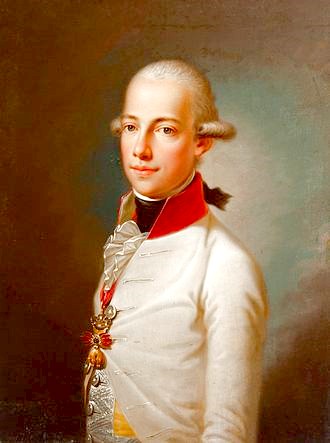 Sárvár,
and Pápa (all in Hungary), chasing the Armee von Innerösterreich under Archduke John,
another brother of Emperor Francis I of Austria and Archduke Charles of Austria, which led to a
confrontation at Györ (then called Raab). Marmont later proceeded directly to Vienna by way of
Wiener Neustadt.
Sárvár,
and Pápa (all in Hungary), chasing the Armee von Innerösterreich under Archduke John,
another brother of Emperor Francis I of Austria and Archduke Charles of Austria, which led to a
confrontation at Györ (then called Raab). Marmont later proceeded directly to Vienna by way of
Wiener Neustadt.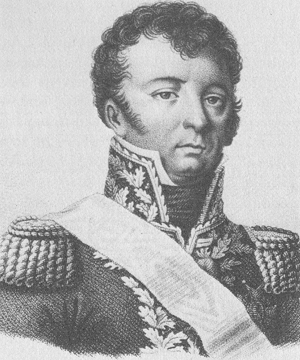 A
second thing I discovered was that one of the French generals in the Danube campaign
terminating at Vienna was Dominique-Joseph René Vandamme! This surname is curiously close
to that of Jean Vandame, the French ancestor of Rainer Saurer that motivated this
article. Wikipedia reports that he was "a brutal and violent soldier, renowned for
insubordination and looting. Napoleon is said to have told him, 'If I had two of you, the
only solution would be to have one hang the other.' Napoleon added that he would give
Vandamme command of the vanguard were he (Napoleon) to launch a campaign against Lucifer in
Hell."
A
second thing I discovered was that one of the French generals in the Danube campaign
terminating at Vienna was Dominique-Joseph René Vandamme! This surname is curiously close
to that of Jean Vandame, the French ancestor of Rainer Saurer that motivated this
article. Wikipedia reports that he was "a brutal and violent soldier, renowned for
insubordination and looting. Napoleon is said to have told him, 'If I had two of you, the
only solution would be to have one hang the other.' Napoleon added that he would give
Vandamme command of the vanguard were he (Napoleon) to launch a campaign against Lucifer in
Hell."